Wombat
Vombatus Ursinus
Spends most of the day underground!
Advertisement
Wombat Scientific Classification
- Kingdom
- Animalia
- Phylum
- Chordata
- Class
- Mammalia
- Order
- Diprotodontia
- Family
- Vombatidae
- Genus
- Vombatus
- Scientific Name
- Vombatus Ursinus
Read our Complete Guide to Classification of Animals.
Wombat Conservation Status
Wombat Facts
- Main Prey
- Grass, Shrubs, Roots
- Habitat
- Woodland and coastal shrub land
- Predators
- Dingo, Fox, Wild dogs
- Diet
- Herbivore
- Average Litter Size
- 1
View all of the Wombat images!
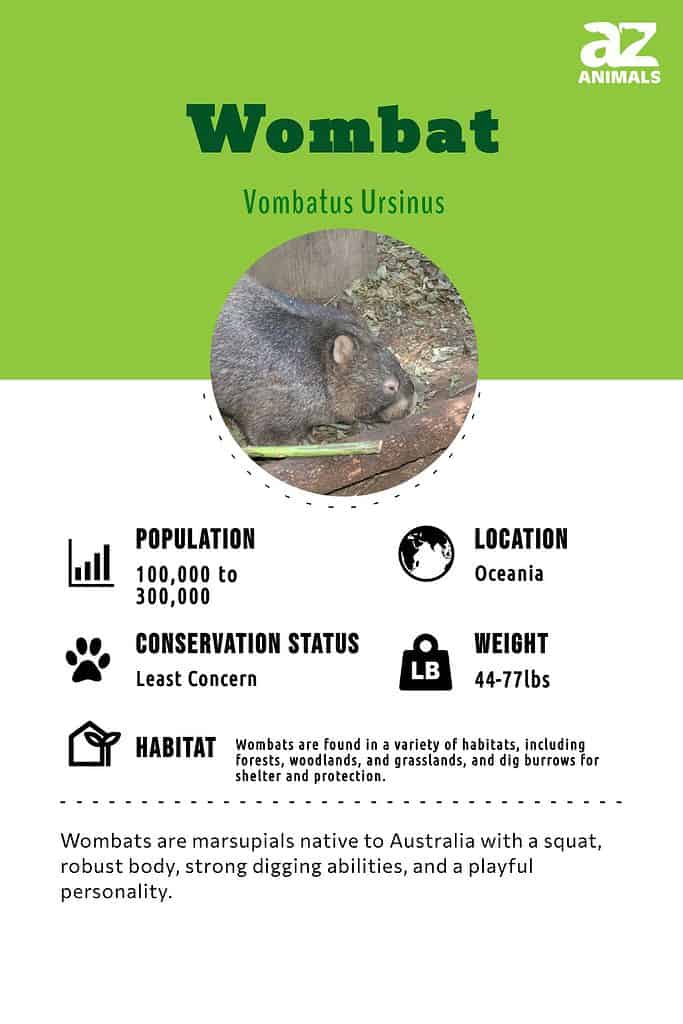
Wombats have cube-shaped poop that they use to mark their territories.
Wombats are chunky little vegetarian animals that live only in Australia and Tasmania. They are marsupials, which means that they carry their babies in a pouch after they are born. Wombats are excellent diggers and create tunnels and burrows to live in.
Their digestive systems are so slow it can take them up to two weeks to digest their food. Although wombats look like easy targets, they have tough backsides that they can use to block predators from eating them.
5 Wombat Facts
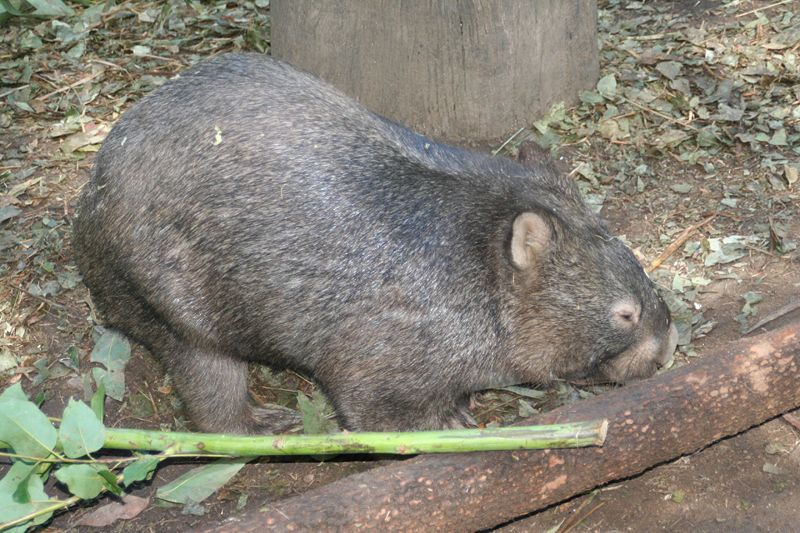
Wombats are animals that live in underground burrows that they dig themselves
©rob & juels / Creative Commons – Original
• Wombats are animals that live in underground burrows that they dig themselves
• Wombat babies love to play and will spend a lot of time and energy having fun
• Some wombats can go weeks, or even months, without ever drinking any water
• Australians celebrate Wombat Day every October 22 in honor of these animals
• Young wombats live in their mother’s pouches for about six months
Make sure to give ‘10 Incredible Wombat Facts‘ a read if you’re looking for more facts on these incredible animals!
Scientific Name
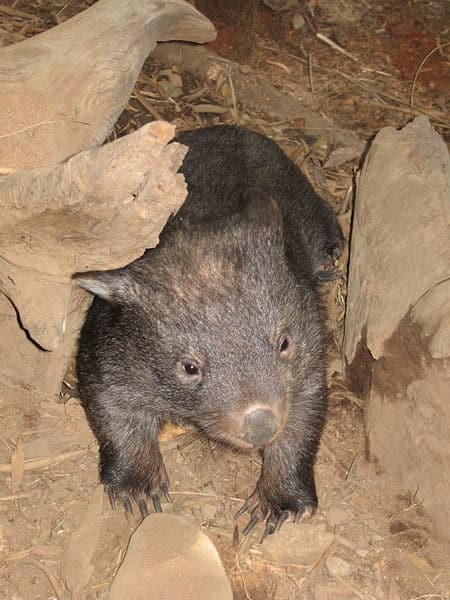
Wombats are animals that live in underground burrows that they dig themselves
©amyrod / Creative Commons – Original
The word ‘wombat’ comes from the Australian Aboriginal name for these animals, either ‘vomat’ or ‘wombac’, which became ‘wombat’ in English. Three species of wombats live in Australia and Tasmania. These are the common wombat, the Northern hairy-nosed wombat, and the Southern hairy-nosed wombat.
The scientific name for the common wombat is Vombatus ursinus. The word ‘Vombatus’ means wombat-like, and ‘ursinus’ means bear-like. The northern hairy-nosed wombat is the Lasiorhinus krefftii, and the southern hairy-nosed wombat is the Lasiorhinus latifrons. ‘Lasio’ means hairy, and ‘rhinus’ means nose, used to describe these wombats with hair on their noses. ‘Krefftii’ is based on Gerard Krefft, who was the Director of the Australian Museum for 10 years, from 1864 to 1874. The term ‘latifrons’ means broad-chested or broad-fronted.
Types of Wombats
- Common wombat
- Northern hairy-nosed wombat
- Southern hairy-nosed wombat
Evolution and Origins
Wombats are marsupials native to Australia and are believed to have originated around 25 million years ago. Fossil evidence suggests that early wombats were similar in size to modern-day Tasmanian devils, and over time they evolved into the larger, slower-moving wombats we see today.
Wombats belong to the family Vombatidae and are one of only a few species of marsupials that have a squat, robust body shape and strong digging abilities. They are well adapted to their environment and use their powerful claws to dig burrows and escape from predators.
Throughout history, wombats have been hunted for their fur and meat, and as a result, some species have become endangered. Conservation efforts are underway to protect these animals and ensure their survival in the wild.
Today, wombats are a beloved and iconic part of Australian wildlife, known for their curious and playful personalities. Their unique physical characteristics and behavior have captured the attention of scientists and the public alike, making them an important part of our understanding of the evolution of marsupials.
Appearance and Behavior
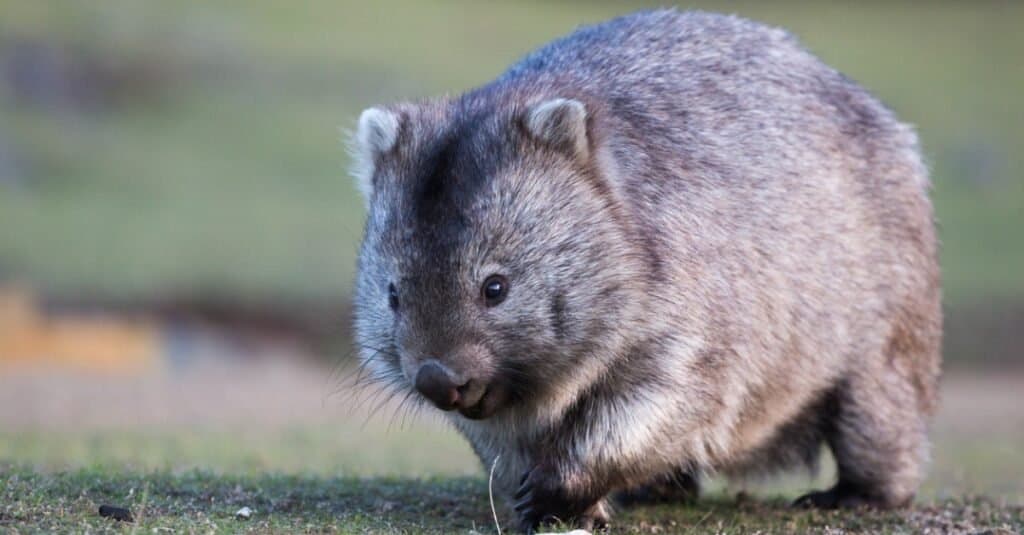
As a marsupial, the wombat has a backwards facing pouch where the young develop. The direction of the pouch means the joey is protected from dirt if the mother is digging.
©Sander Groffen/Shutterstock.com
Wombats are animals that have a heavy, sturdy appearance, looking something like small, gray, tan, or brown bears. They have short, dense fur that is long enough to provide them with some protection but short enough not to get filled with weeds and dirt. Their triangular ears stick up from their heads and they have little stubby tails.
These animals have short, powerful legs that have big, heavy claws on them that wombats can use for digging. They are marsupials, so the females have pouches in which they raise their babies, but their pouches face backward, towards their tails, so the babies don’t get pelted with dirt as their mothers dig tunnels and holes.
Wombats are 31 to 47 inches (80 to 129 cm) long and weigh anywhere from 32 to 80 pounds (14.5 to 36.29 kg). That’s about the same weight as a full-grown Labrador retriever, but on short legs that make a wombat stand no higher than an adult person’s knees. The biggest wombat ever recorded weighed 88 pounds (40 kg), about the same weight as a newborn calf. He lived in a wildlife park in Australia and was known as “Patrick.”
Common wombats normally live alone in individual burrows. Hairy-nosed wombats may share a large burrow with others of their kind. These burrows can be nearly 100 feet (30 m) long, with as many as 20 entrances. A group of wombats is called a mob or a colony.
Typically shy, wombats are nocturnal. Humans may live in the same area and yet never see a wombat, as these animals tend to hide from danger. Despite their shyness, they can get very aggressive in some situations, especially around the breeding time when they will bite and scratch each other. Real fighting is rare, however, and typically the wombat that loses a fight will leave rather than fight until he is injured. Because of this, wombats are not considered good pets.
Wombats have a thick layer of cartilage covering their rear ends. If a predator tries to attack a wombat it will head into its burrow leaving only its rear for the predator to attack. The attacking animal is usually unable to bite through this tough cartilage, so the wombat escapes danger. The wombat may also use his rear legs to kick at the predator, often injuring it with the heavy back claws.
Wombat Habitat
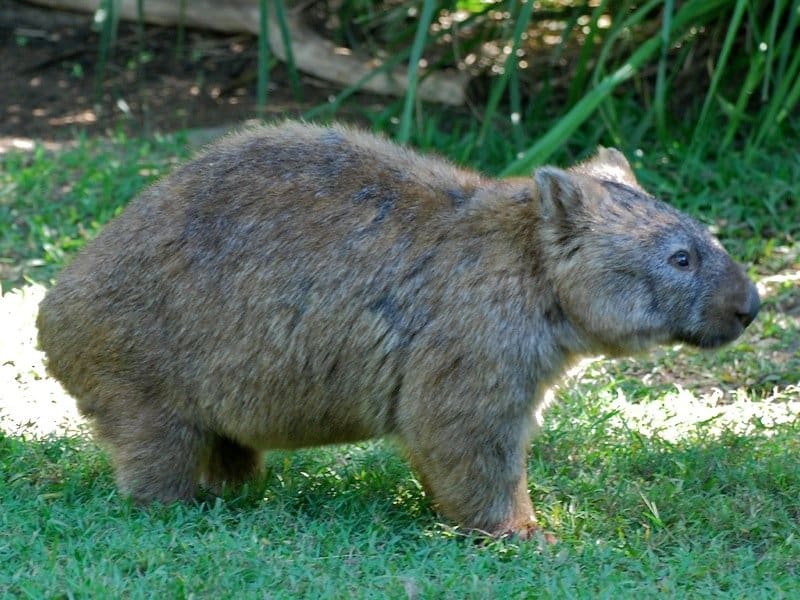
Wombats live only in Australia or Tasmania. Their range is limited to sections of Southern Eastern Australia along the coast, plus Tasmania and Flinders Island. They used to cover more territory, but conflicts with humans plus environmental struggles have caused their numbers and their territory to shrink. Wombats can be found living in open areas both in the mountains and on flat lands, as long as there is sufficient open space for them to dig their burrows.
The nocturnal wombats sleep in their burrows during the day, coming out at night to feed. Because they are nocturnal, wombats are seldom seen by humans. Their burrows are troublesome for ranchers as they can cause injury to livestock, and so ranchers who discover wombats on their land may try to get rid of them.
Diet
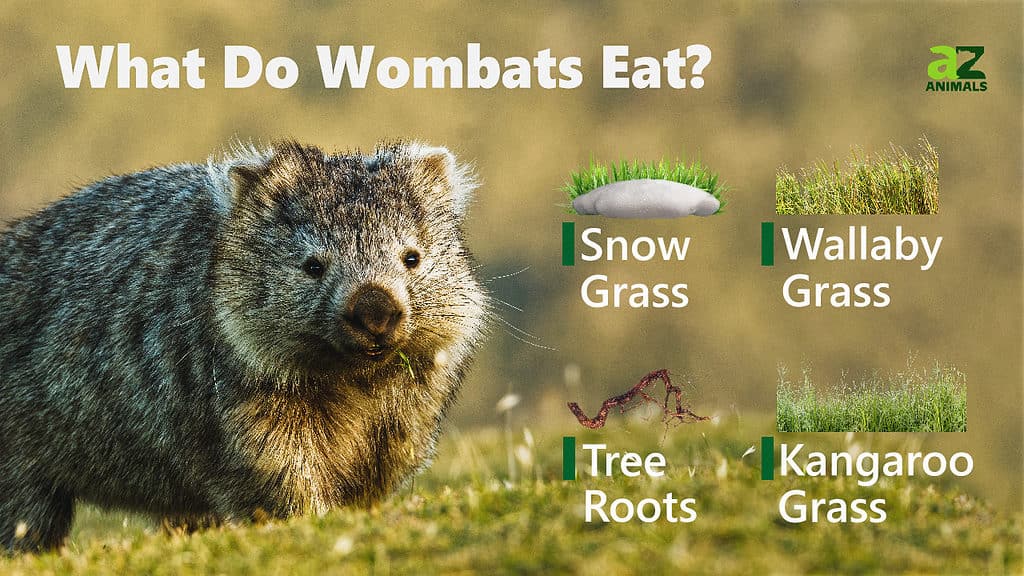
Wombats are vegetarians that eat most of the different plants that grow in their territories. This includes spear grass, snow tussocks, herbs, grassroots, trees, shrubs, fungi such as mushrooms, bark, bushes, moss, march plants, and leaves. They prefer tender young plants but they’ll eat almost anything when they find it, including vegetables grown by humans. If there’s a drought, wombats will dig down amongst the grasses to reach the grassroots to eat.
Wombats need less food than other animals of the same size because they have a very slow metabolism. This means they don’t have to spend as much time foraging for food, allowing them to conserve energy. They have also developed the ability to spend as much as two weeks digesting their food, giving their bodies time to extract as many nutrients as possible from the foods they eat.
Because they live in a very dry climate, hairy-nosed wombats are adapted to going for long periods without the need to drink water. They satisfy most of their water needs with the water they get from plants and from lapping up the dew. Common wombats will seek out water to drink. All wombats enjoy drinking after it rains and will seek out puddles and pools.
Predators and Threats

Wombats are hunted by several different predators, including dingoes, foxes, and Tasmanian devils.
©PanBK / Creative Commons – Original
Wombats are hunted by several different predators, including dingoes, foxes, and Tasmanian devils. Young wombats are also preyed upon by eagles and owls. In many areas, dogs kill wombats. Humans are one of the greatest threats to wombats, since many people wombats as pests or varmints, and will hunt, trap, and poison them to get rid of them. While the wombats are protected throughout most of their territory now, areas remain where they are routinely killed by people.
Other animals also compete with wombats for the few resources available in the areas in which they live. Rabbits, sheep, and cattle are all animals that were introduced by humans and are now driving wombats out of their natural territories. Not only do they eat the same foods, but rabbits will move into wombat burrows if they can, and cattle destroy the burrows if they step on them.
Starvation kills many wombats, especially in dry years. Another serious threat to wombats is the presence of roads. Wombats are routinely killed by cars at night since they can be hard to spot in the dark. Hundreds are killed each year, both adults and babies.
The common wombat is listed as an animal of least concern (LC) by the International Union for the Conservation of Nature (IUCN), meaning that at this point there is no concern about them becoming extinct. The Southern hairy-nosed wombat is also listed as being of least concern. The Northern hairy-nosed wombat, however, is considered to be critically endangered, with only about 500 of them surviving in the wild.
Reproduction, Babies, and Lifespan
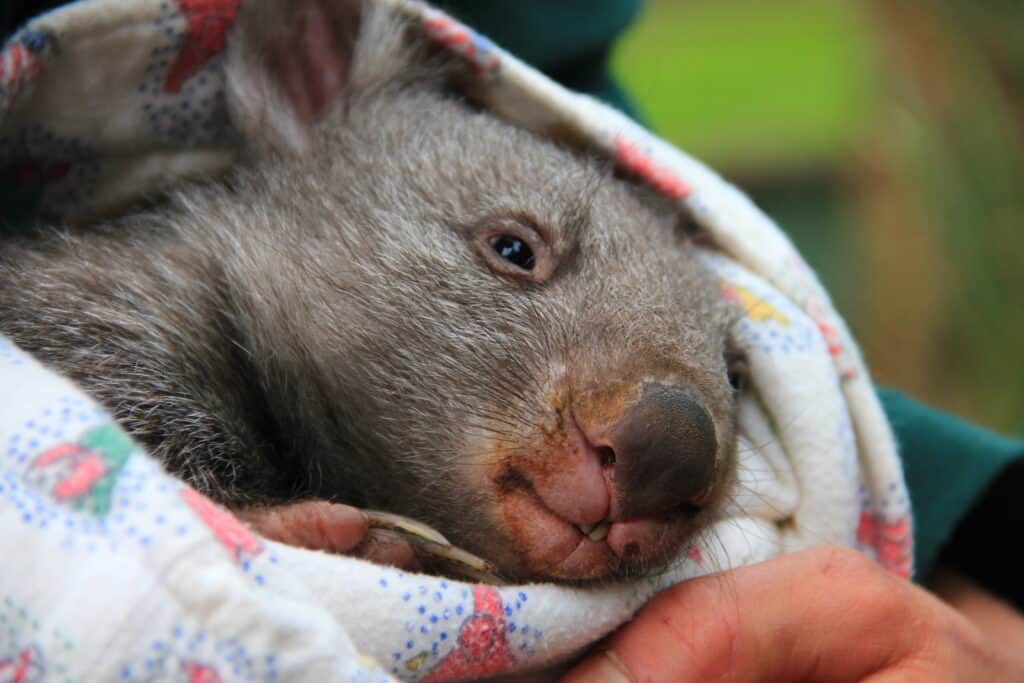
Wombats are usually mature and able to have babies by two years of age.
©Flash-ka/Shutterstock.com
Wombats are usually mature and able to have babies by two years of age. They don’t have a specific breeding season. When a female is ready to breed, she will scatter her poop cubes around the area where she lives. These cubes have pheromones on them that signal that she is ready for any males in the area. The pair will come together for breeding but then they will separate and the mother will raise the baby, called a joey, by herself.
The wombat is a marsupial, which means that the females have pouches they carry their babies in once they are born. Gestation time is 20 to 22 days and typically produces only a single joey. When the baby is born it is tiny, helpless, blind, and about the size of a jelly bean. It cannot survive on its own. After birth, the joey makes its way to its mother’s pouch and climbs inside, where it will remain for up to six months. At this time, it is ready to emerge and begins to explore the world but it will climb back in the pouch for safety or comfort and will stay with its mother for as much as another year.
It is common for wombats to live anywhere from 5 to 20 years in the wild, though wombats in captivity have been known to get as much as 30 years old. Frequently wild wombats fall victim to predators, disease, starvation, or they are hit by cars when trying to cross the road at night.
Population
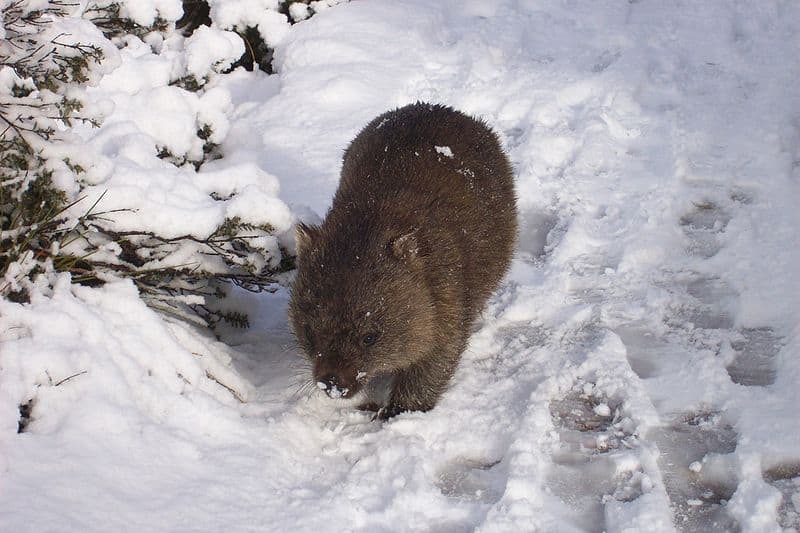
Estimates for the number of Southern hairy-nosed wombats guess their population to be somewhere between 100,000 and 300,000.
©Brandy Frisky / Creative Commons – Original
The number of wombats living in the wild is unknown. Common wombats are considered plentiful but there are no current estimates on how many of them there are. The species is listed as being of least concern, meaning their numbers seem to be sufficient to sustain them.
Estimates for the number of Southern hairy-nosed wombats guess their population to be somewhere between 100,000 and 300,000. These are also listed as being the species of least concern. The number of Northern hairy-nosed wombats is better known, as they live in a very tiny patch of wilderness in Southeastern Australia. Due to conservation efforts, this species is increasing, but there are still less than 500 of them at this time and they continue to be considered as critically endangered.
Wombat FAQs (Frequently Asked Questions)
Are wombats carnivores, herbivores, or omnivores?
Wombats are herbivores. They eat all kinds of plant matter, such as grass, moss, shrubs, bark, roots, mushrooms, and leaves. Wombats never consume any kind of meat or fish.
Why is wombat poop square?
Nobody is completely sure why wombat poop is square, but scientists think it is because wombats use their poop to mark their territories, and the square shape prevents it from rolling off of rocks or other places where they leave it.
Are wombats dangerous?
Wombats are wild animals with teeth and claws, and they can be dangerous if they feel trapped or threatened. A person couldn’t easily escape an angry wombat, since they can run up to 25 miles per hour, much faster than the average person. They’re also big and powerful enough to cause serious harm by biting or scratching.
Are wombats friendly?
Wombats can be friendly if they have been raised around people. Wild wombats are unlikely to be friendly to humans.
Is a wombat a good pet?
No, wombats don’t make good pets. They are wild animals and should be treated as such. It is illegal in Australia to keep a wombat as a pet. People who want to interact with wombats can become animal caregivers and become licensed to rehabilitate wombats, but the ultimate goal is to return wombats to the wild, not to keep them as pets.
Are wombats protected animals?
Wombats are protected by law in much of Australia, meaning it is illegal to shoot, trap, or poison them. The exception to this is that in some parts of the country these animals are still considered as pests, and the people there are allowed to kill wombats to protect farms or ranch lands.
How can wombats live without water?
Southern hairy-nosed wombats can live for long periods without drinking water because they absorb moisture from the food they eat. They also lick dew from leaves and other surfaces to get water, but they will drink when given an opportunity to do so.
What Kingdom do Wombats belong to?
Wombats belong to the Kingdom Animalia.
What phylum do Wombats belong to?
Wombats belong to the phylum Chordata.
What class do Wombats belong to?
Wombats belong to the class Mammalia.
What family do Wombats belong to?
Wombats belong to the family Vombatidae.
What order do Wombats belong to?
Wombats belong to the order Diprotodontia.
What genus do Wombats belong to?
Wombats belong to the genus Vombatus.
What type of covering do Wombats have?
Wombats are covered in Fur.
In what type of habitat do Wombats live?
Wombats live in woodland and coastal shrub land.
What is the main prey for Wombats?
Wombats prey on grass, shrubs, and roots.
What are some predators of Wombats?
Predators of Wombats include dingos, foxes, and wild dogs.
What is the average litter size for a Wombat?
The average litter size for a Wombat is 1.
What is an interesting fact about Wombats?
Wombats spend most of the day underground!
What is the scientific name for the Wombat?
The scientific name for the Wombat is Vombatus Ursinus.
What is the lifespan of a Wombat?
Wombats can live for 20 to 26 years.
How fast is a Wombat?
A Wombat can travel at speeds of up to 25 miles per hour.
What's the difference between a wombat and a capybara?
The main difference between a capybara and a wombat is that a wombat is a marsupial while a capybara is a large rodent. Wombats also dig tunnels, while capybaras enjoy spending their life in the water.
Thank you for reading! Have some feedback for us? Contact the AZ Animals editorial team.
Sources
- David Burnie, Dorling Kindersley (2011) Animal, The Definitive Visual Guide To The World's Wildlife / Accessed November 13, 2008
- Tom Jackson, Lorenz Books (2007) The World Encyclopedia Of Animals / Accessed November 13, 2008
- David Burnie, Kingfisher (2011) The Kingfisher Animal Encyclopedia / Accessed November 13, 2008
- Richard Mackay, University of California Press (2009) The Atlas Of Endangered Species / Accessed November 13, 2008
- David Burnie, Dorling Kindersley (2008) Illustrated Encyclopedia Of Animals / Accessed November 13, 2008
- Dorling Kindersley (2006) Dorling Kindersley Encyclopedia Of Animals / Accessed November 13, 2008
- David W. Macdonald, Oxford University Press (2010) The Encyclopedia Of Mammals / Accessed November 13, 2008


















